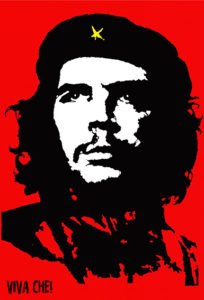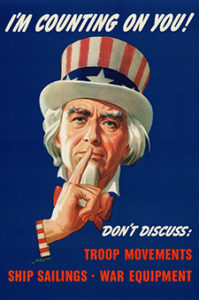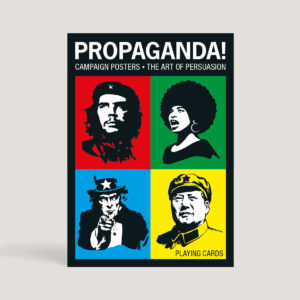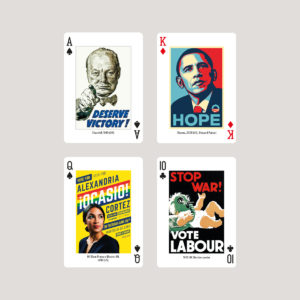THE ART OF PERSUASION
 How far can ELECTION POSTERS go in demonising the opposition? In 1999, a UK poster featured Tony Blair with the caption BLIAR in lurid yellow. Strong meat in decorous Britain. Yet pallid compared to US politics. In 1856 the (newly formed) Republicans depicted the Democrats’ candidate, James Buchanan, as a jackass. ‘A true likeness’ the text said and added ‘P.S. Jimmy, you cannot win!’ Wrong. In the US 1828 election, handbills accused the Democrat Andrew Jackson, the hero of the War of 1812, of being an illiterate drunkard – and a murderer. Jackson’s opponent, President John Quincy Adams, was portrayed as a pimp. Jackson won.
How far can ELECTION POSTERS go in demonising the opposition? In 1999, a UK poster featured Tony Blair with the caption BLIAR in lurid yellow. Strong meat in decorous Britain. Yet pallid compared to US politics. In 1856 the (newly formed) Republicans depicted the Democrats’ candidate, James Buchanan, as a jackass. ‘A true likeness’ the text said and added ‘P.S. Jimmy, you cannot win!’ Wrong. In the US 1828 election, handbills accused the Democrat Andrew Jackson, the hero of the War of 1812, of being an illiterate drunkard – and a murderer. Jackson’s opponent, President John Quincy Adams, was portrayed as a pimp. Jackson won.
CAMPAIGN GIMMICKS
In 1836, the Whig William Henry Harrison’s campaign showed him as a youthful warrior atop a white horse; he’s also pictured making cider and ploughing, with the log cabin of his birth behind. The military bit was true – he won the Battle of Tippecanoe (1811) over the American Indians. But the rest is piffle. He was 67. He was raised in a Virginia mansion. Although he lost that election to Martin Van Buren, he beat him in 1840 because the economy had crashed (‘It’s the economy stupid’). The 1840 election started trends that persist. Gimmicks. Campaign gewgaws. Ditties. Slogans – Harrison’s included his running mate, John Tyler (who became President after Harrison died in office) – ‘For Tippecanoe and Tyler Too.’ Free hard cider was poured at rallies; there were Harrison hankies and shaving cream and coffee pots. E.C. Booz of Philadelphia marketed ‘Old Cabin Whiskey’ in log cabin bottles (thus the name ‘booze’).
SLOGANS
 Henceforth every candidate had their slogan, some memorable: ‘Turn the Rascals Out’ (Greeley, 1872), ‘Dewey or don’t we’ (Dewey, 1940), ‘I like Ike’ (Eisenhower, 1952), ‘All the way with LBJ’ (Johnson, 1964), ‘In Your Heart, You Know He’s Right’ (Goldwater, 1964, a disastrous slogan that gave rise to ‘In Your Guts, You Know He’s Nuts’); ‘Nixon’s the One’ (Richard Nixon, 1968 – a campaign that also prompted the double entendre ‘They can’t lick our Dick’); ‘Yes We Can’ (Obama, 2008); ‘Make America Great Again!’ (Trump, 2016, used originally by Reagan in 1980). Mitt Romney’s slogan ‘Obama Isn’t Working’ (2012) was pinched from the Tories’ iconic 1978 poster ‘Labour Isn’t Working’, showing a long dole queue. Mrs Thatcher initially rejected it – ‘You should never have the other side’s name in your own poster!’ The double entendre was explained. She didn’t get it. [The people in the line were actually Young Conservatives posing.] Thankfully, toe-curling campaign songs are now dead. JFK’s 1960 High Hopes should have lost him the election. The patrician Mrs K despised it. She would have loathed the vulgarity of lazy modern posters, like Jack Kemp’s (1988) where the candidate, plus wife and 7 kiddies (!), grin in front of Old Glory. Sometimes puppies are thrown in.
Henceforth every candidate had their slogan, some memorable: ‘Turn the Rascals Out’ (Greeley, 1872), ‘Dewey or don’t we’ (Dewey, 1940), ‘I like Ike’ (Eisenhower, 1952), ‘All the way with LBJ’ (Johnson, 1964), ‘In Your Heart, You Know He’s Right’ (Goldwater, 1964, a disastrous slogan that gave rise to ‘In Your Guts, You Know He’s Nuts’); ‘Nixon’s the One’ (Richard Nixon, 1968 – a campaign that also prompted the double entendre ‘They can’t lick our Dick’); ‘Yes We Can’ (Obama, 2008); ‘Make America Great Again!’ (Trump, 2016, used originally by Reagan in 1980). Mitt Romney’s slogan ‘Obama Isn’t Working’ (2012) was pinched from the Tories’ iconic 1978 poster ‘Labour Isn’t Working’, showing a long dole queue. Mrs Thatcher initially rejected it – ‘You should never have the other side’s name in your own poster!’ The double entendre was explained. She didn’t get it. [The people in the line were actually Young Conservatives posing.] Thankfully, toe-curling campaign songs are now dead. JFK’s 1960 High Hopes should have lost him the election. The patrician Mrs K despised it. She would have loathed the vulgarity of lazy modern posters, like Jack Kemp’s (1988) where the candidate, plus wife and 7 kiddies (!), grin in front of Old Glory. Sometimes puppies are thrown in.
PROPAGNDA POSTERS
The most effective PROPAGANDA POSTERS use solid primary colours and a stark message; mendacious perhaps, bossy certainly. The most powerful graphics often came from early Soviet Russia and Nazi Germany (Mao’s China stifled creative design). In the Third Reich, from 1936-43, 125,000 posters were produced every week to ‘educate’ citizens into the correct attitude towards Jews, thrift and the enemy. Britain’s vast output added something the Nazis omitted. Humour. Nazis caricatured Churchill as a monster; cartoonists like Fougasse and Low depicted Adolph and Musso as buffoons. But officiousness still seeped through, which Fougasse lampooned in a Punch cartoon showing an obedient Englishman staring at posters telling him to EAT MORE SAGO, EAT MORE BUNS etc, getting fatter and fatter and then bursting. The British are contrary and don’t like being told to be ‘resolute’, as posters incessantly urged. The Tories lost the 1945 election. Noël Coward saw that after 6 years of ‘forced cheeriness in the face of imminent disaster’ people longed to moan again. ‘We’re going to unpack our troubles from our old kit bag / And wait until we drop down dead.’ In the US propaganda war, the cussed brawler Donald Duck was drafted; cartoons like Donald Duck in Nutziland and patriotic posters (‘I get exasperated at people who squawk’) brought Allied victory closer. Hitler could fight an army, but not the combative all-American everyman. When my uncle saw Commando Duck (1944) he said, quoting Victor Laszlo in Casablanca – ‘This time I know our side will win.’


